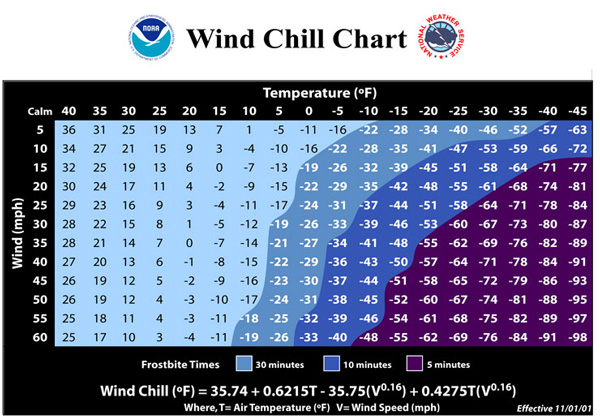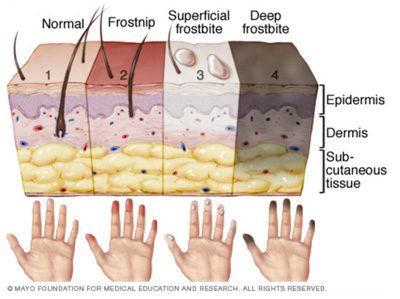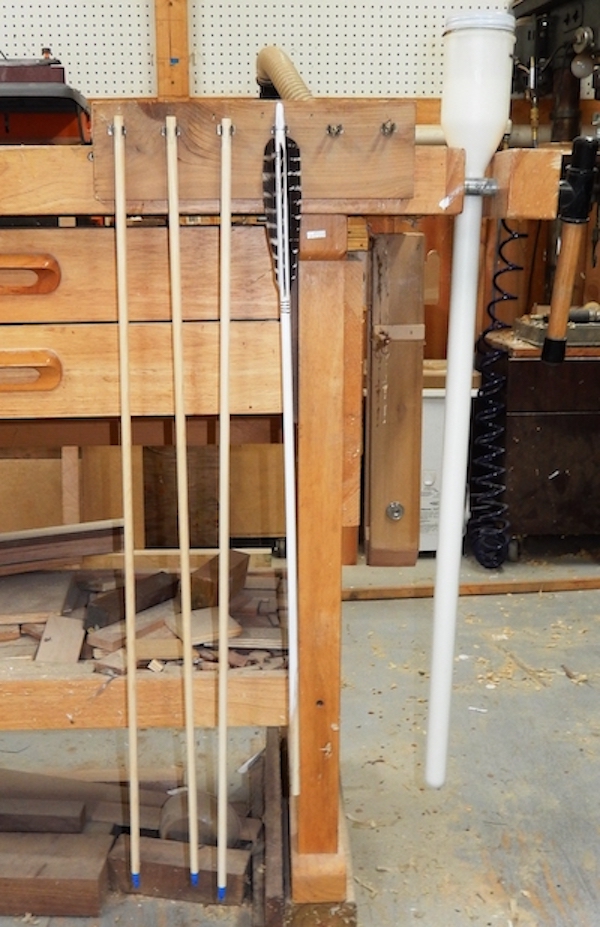Many traditional bowhunters go afield when the weather is very cold; it’s part of the challenge of hunting, but it can also be dangerous if you aren’t prepared. Frostbite can happen in a matter of minutes, and the body tries to keep your vital organs warm by cutting off circulation to your fingers and toes. This chart will give you an idea of how quickly frostbite can happen.

The following information was gathered from the National Weather Service website, and there is a lot more information there for cold weather preparedness. To avoid frostbite, cover all exposed areas including your ears and nose. Wearing mittens instead of gloves will keep your fingers warmer, but it could be a problem shooting your bow. Many bowhunters use chemical hand warmers. Additionally, you should keep your skin dry, try to stay out of the wind, drink plenty of water to increase your blood volume, and avoid caffeine, alcohol and cigarettes.
 The four degrees of frostbite are ice crystals forming on the skin; skin that feels warm even though it is not defrosted; skin that turns red, pale or white; and the most serious is pain that lasts more than a few hours and skin that may turn blue or black. At that point you should see a doctor immediately!
The four degrees of frostbite are ice crystals forming on the skin; skin that feels warm even though it is not defrosted; skin that turns red, pale or white; and the most serious is pain that lasts more than a few hours and skin that may turn blue or black. At that point you should see a doctor immediately!
With any of these signs you should get indoors as quickly as possible, but until you do here are a few things that might help: put your hands into your armpits; hold onto another person or animal; drink warm liquids; put on extra layers of clothes, blankets, etc.; remove rings, watches or other tight jewelry. Don’t rub or massage cold body parts.
Once you get indoors, don’t walk on a frostbitten foot, you could cause more damage. Get into a warm (104-108°), NOT HOT, bath and wrap your face and ears in a moist, warm, NOT HOT, towel. Don’t get near a hot stove or heater, or use a heating pad, hot water bottle, or hair dryer. You may burn yourself before feeling returns to the frostbitten area.
Frostbitten skin will become red and swollen, and feel like it’s on fire. You may develop blisters. Don’t break the blisters as it could cause scarring and infection. If your skin turns blue or gray, is very swollen, blistered or feels hard and numb even under the surface, go to a hospital as soon as possible.
Cold weather hunts can be exciting and invigorating. Whether you are sitting in a stand or blind, field dressing an animal, or chasing a mountain lion, you should know the warning signs and treatment of frostbite. Stay safe out there!







My personal frostbite prevention is thus: if it is really cold out, don’t go out.
Great and usefull tip.
Many of us don’t have idea how hard could be a combination of some enviromental conditions.
Some of us do have an idea. 😉
“URGENT – WINTER WEATHER MESSAGE
National Weather Service Duluth MN
1037 AM CST Wed Dec 11 2019
…BITTERLY COLD WIND CHILLS CONTINUE FOR THE REST OF THE
MORNING…
…ACCUMULATING SNOW TONIGHT INTO THURSDAY MORNING…
.Very cold wind chill values of 25 to 35 degrees below zero will
persist through noon today across much of northeastern Minnesota
and portions of northwestern Wisconsin. A Wind Chill Advisory
remains in effect until noon today.”
And I would be out today, except I have to work:
https://youtu.be/0J3hzdQhNAs
Good message. Another “tip” is to keep a good attitude. In the 1960s I worked on the White Alice Communications System in Alaska. While there, the mechanic at the Indian Mountain site (not where I was stationed) went caribou hunting with a couple of the Air Force boys. He wore long woolie, jeans, wool shirt and a down jacket, hat, mittens and mukluks. The other two guys had their issue cold weather clothing, including fat boy pants, parka and bunny boots.
They got off the road and down into deep snow, when one of the GIs tripped and broke his leg. There was no way to get him out with just the two others, so the mechanic told the second kid to go back up to the truck and get help while he stayed with the hurt guy. It got dark and a rescue party couldn’t get to them until the following morning, IIRC. When they did, they found the mechanic in good shape while the other guy had died. The mechanic said he tried to keep him going but hes aid at one point he could just see the kid give up and shortly after he passed away. There was apparently nothing to build a fire with.
The moral is that the mechanic didn’t have the extra insulation that Uncle Sam provided the GIs, but he didn’t give up that they would get rescued while the other guy did.
Good information!